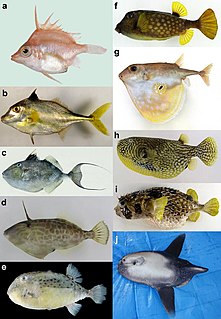
The Tetraodontiformes are an order of highly derived ray-finned fish, also called the Plectognathi. Sometimes these are classified as a suborder of the order Perciformes. The Tetraodontiformes are represented by 10 extant families and at least 349 species overall; most are marine and dwell in and around tropical coral reefs, but a few species are found in freshwater streams and estuaries. They have no close relatives, and descend from a line of coral-dwelling species that emerged around 80 million years ago.

Cirrhitidae, the hawkfishes, are a family of marine perciform ray-finned fishes found in tropical seas and which are associated with coral reefs.

Elasmobranchii is a subclass of Chondrichthyes or cartilaginous fish, including sharks, rays, skates, and sawfish. Members of this subclass are characterised by having five to seven pairs of gill clefts opening individually to the exterior, rigid dorsal fins and small placoid scales on the skin. The teeth are in several series; the upper jaw is not fused to the cranium, and the lower jaw is articulated with the upper. The details of this jaw anatomy vary between species, and help distinguish the different elasmobranch clades. The pelvic fins in males are modified to create claspers for the transfer of sperm. There is no swim bladder; instead, these fish maintain buoyancy with large livers rich in oil.

Fangtooths are beryciform fish of the family Anoplogastridae that live in the deep sea. The name is from the Greek anoplo, meaning "unarmed", and γαστήρ, meaning "stomach". With a circumglobal distribution in tropical and cold-temperate waters, the family contains only two very similar species in one genus, with no known close relatives.

The sharpnose sevengill shark, also known as one-finned shark, perlon shark, sevengill cow shark, sharpsnouted sevengill or slender sevengill, is a species of shark in the family Hexanchidae, and the only living species in the genus Heptranchias. Found almost circumglobally in deep water, it is one of the few species of sharks with seven pairs of gill slits as opposed to the usual five. The other shark species with seven gill slits is the broadnose sevengill shark. Though small, this shark is an active, voracious predator of invertebrates and fish. When caught, this species is notably defensive and will attempt to bite. It is of minor commercial importance.
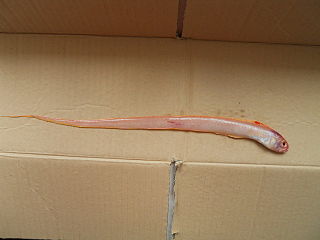
The bandfishes, family Cepolidae, are 23 species of marine ray-finned fishes, They are native to the East Atlantic and Indo-Pacific wherethey dig burrows in sandy or muddy seabeds and eat zooplankton.
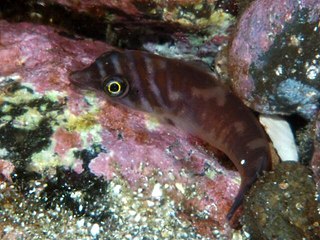
Clingfishes are fishes of the family Gobiesocidae, the only family in the order Gobiesociformes. These fairly small to very small fishes are widespread in tropical and temperate regions, mostly near the coast, but a few species in deeper seas or fresh water. Most species shelter in shallow reefs or seagrass beds, clinging to rocks, algae and seagrass leaves with their sucking disc, a structure on their chest.

The marbled parrotfish, also known as the seagrass parrotfish, is a species of marine ray-finned fish, a parrotfish from the family Scaridae and is the only known member of the genus Leptoscarus. It has a wide Indo-Pacific distribution and is also found in the southeastern Atlantic Ocean. It is a coastal species found in beds of sea grass and seaweed.
The weasel sharks are a family, the Hemigaleidae, of ground sharks found from the eastern Atlantic Ocean to the continental Indo-Pacific. They are found in shallow coastal waters to a depth of 100 m (330 ft).
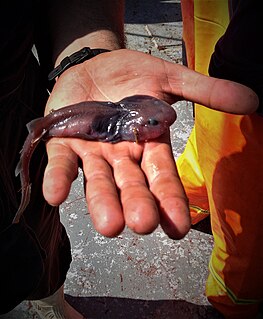
The lollipop catshark is a little-known species of deep sea catshark, belonging to the family Scyliorhinidae, and the only described member of its genus. A diminutive, bottom-dwelling shark of the outer continental shelf and upper continental slope, this species can be readily identified by its tadpole-like shape with a greatly expanded, rounded head and narrow body. The large head houses expanded gills, which are thought to be an adaptation for hypoxic conditions. This shark preys on crustaceans and fishes. Reproduction is aplacental viviparous, with females retaining egg cases internally two at a time until they hatch. There is no fishery interest in this species.
Modicus tangaroa is a clingfish of the family Gobiesocidae, found only around New Zealand where it occurs on coarse substrates consisting of shell fragments and bryozoa at depths of 20–149 metres (66–489 ft). This species was described by Grahma S Hardy in 1983 from types collected from the research vessel Tangoroa over the Ranfurly Bank, East Cape in New Zealand, the species was named after the vessel.

Callorhinchus, the plough-nosed chimaeras or elephantfish, are the only living genus in the family Callorhinchidae. A few extinct genera only known from fossil remains are recognized. Callorhinchus spp, are similar in form and habits to other chimaeras, but are distinguished by the presence of an elongated, flexible, fleshy snout, with a vague resemblance to a ploughshare. They are only found in the oceans of the Southern Hemisphere along the ocean bottom on muddy and sandy substrates. They filter feed, with small shellfish making up the bulk of their diet. The plough-nosed chimaera lays eggs on the ocean floor that hatch at around 8 months. They are currently not a target of conservation efforts; however, they may be susceptible to overfishing and trawling.

Mycteroperca is a genus of marine ray-finned fish, groupers from the subfamily Epinephelinae, part of the family Serranidae, which also includes the anthias and sea basses. They are predatory fish, largely associated with reefs and are found in tropical and subtropical seas in the Atlantic Ocean and the eastern Pacific Ocean. They are important target species for fisheries.
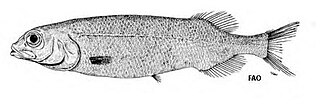
Bajacalifornia is a genus of slickheads. It was described in 1925 by Charles Haskins Townsend and John Treadwell Nichols on the basis of Bajacalifornia burragei which was discovered in 1911 during the deep sea expedition of the research vessel USS Albatross off the coast of Todos Santos Bay at the Baja California peninsula. In 1952 Ichthyologist Albert Eide Parr published a revision of this genus.

Harpagifer, the spiny plunderfishes is a genus of marine ray-finned fishes, belonging to the family Harpagiferidae, it is the only genus in this monotypic family. They are found in the Southern Ocean.

Most bony fishes have two sets of jaws made mainly of bone. The primary oral jaws open and close the mouth, and a second set of pharyngeal jaws are positioned at the back of the throat. The oral jaws are used to capture and manipulate prey by biting and crushing. The pharyngeal jaws, so-called because they are positioned within the pharynx, are used to further process the food and move it from the mouth to the stomach.

The longrakered trevally, also known as the cale cale trevally and heavyjawed kingfish, is a species of marine fish in the jack and horse mackerel family Carangidae. The longrakered trevally is distributed throughout the tropical and subtropical waters of the Indian and west Pacific Oceans, from Mozambique and Madagascar in the west, to Japan and northern Australia in the east. A large species growing to a recorded length of 1 m, the longrakered trevally is distinguished by is protruding lower jaw, elongated gill rakers and lack of villiform teeth on its tongue. It is an inshore species, restricted to coastal and estuarine regions, where it preys on fishes and crustaceans. Little is known of the species reproductive cycle or growth. The longrakered trevally is of minor importance to fisheries and is often taken as bycatch in finfish and prawn trawls, as well as by recreational fishermen.
Derilissus is a genus of clingfishes belonging to the family Gobiesocinae found in the western Atlantic Ocean. This family of fish is identified by their appearance as small fish with sucking discs which allow them to attach themselves to various surfaces. Derilissus differs from other genera due to its attached gill membranes.

Kopua is a genus of clingfishes found in the Pacific Ocean.

Diplecogaster bimaculata, the two-spotted clingfish, is a species of fish in the family Gobiesocidae found in Black Sea, Mediterranean Sea and Atlantic Ocean where it is found on rocks and among seagrass or shell beds.

















